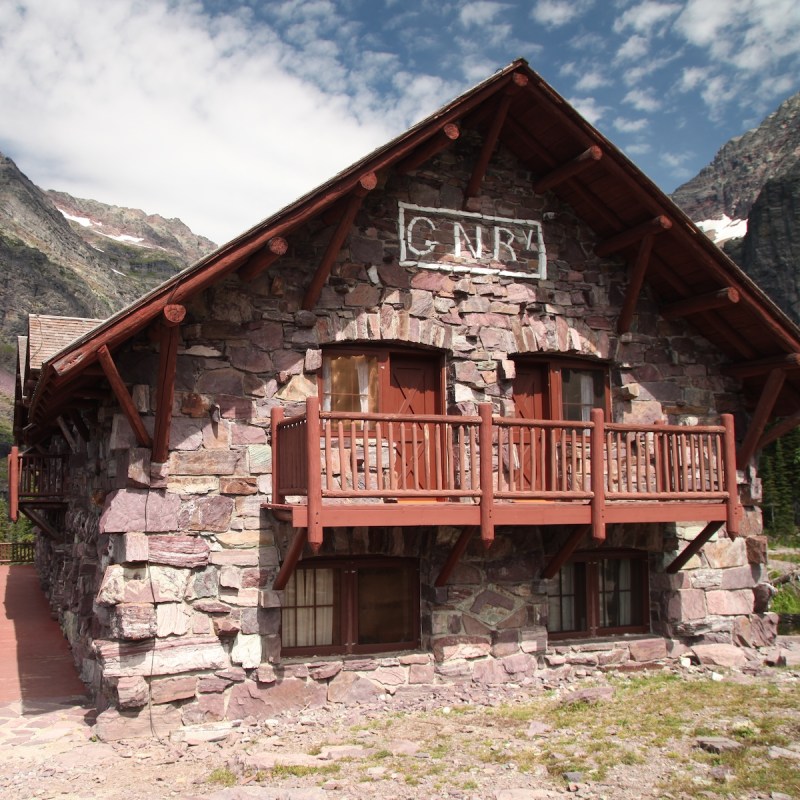
Sperry Chalet is perched high on the side of Edwards Mountain in a glacier basin at 6,500 feet elevation. The chalet is on the west side of the park and is most easily hiked to from Lake McDonald Lodge. In fact, the trailhead is right across the road from the lodge parking lot.
Videos by TravelAwaits
This nearly 7-mile hike gains about 32-hundred feet elevation, so it is a strenuous walk. The payoff, if you have reservations at the chalet, is a comfortable night in the mountains with three meals.

1. It Maybe A Long Walk, But The Vistas Are Amazing
As you leave the area of the lodge parking lot, you climb through cedar and hemlock forest, and to your left is the horse stable. These horses are for hire, and they are also used to carry supplies to the chalet, including linen, food, and even propane.
As you climb up, you’ll be able to look to the right and see Sprague Creek tumbling over the rocks below.
Pro Tip: Walking all the way to Sperry Glacier is MORE than a day hike at about 18 miles. Get reservations at the chalet and break up the walk over two days.
2. Don’t Be Distracted By Side Trails Or Cool Water
As you continue to climb, two trails come in from the left relatively close to each other. The first takes you to the top of Mount Brown, where there’s a closed fire lookout. The second trail takes you to Snyder Lake, which lies in a basin at the foot of Mt. Brown. The lake is named for George Snyder, who in the early days saw the potential for tourism in Glacier. He built a fish camp for tourists where Lake McDonald Lodge is today.
After the side trails, you cross Snyder Creek (there’s also a Snyder Ridge!). This is called Crystal Ford. There’s another trail split here. To the right, a side trail takes you to Fish Lake, but we are pushing to the left and the chalet, and maybe Sperry Glacier.
3. Fire Damaged This Forest, But There’s New Life
Fires are considered a natural part of the forest environment. The Sprague fire burned this part of the trail. The fire also razed the Sperry Chalet in August 2017. The fire hopscotched through the woods, leaving a patchwork of burn areas. The Sprague Fire burned almost 17,000 acres.
While the burn areas look bad, look closer and see all the regeneration of the forest. There are new flowers growing, especially pink fireweed. Down close to the ground are new trees, lodgepole pines, which depend on fire to spread their seeds.
Pro Tip: Since the fire burned in a patchwork, there are some really sunny spots on the trail. Be ready with sunscreen, a hat, and plenty of water. Going uphill for those miles is hot work on a summer day.

4. The Chalet Burned In 2017
Sperry Chalet was built by the Great Northern Railroad in 1913. It was part of the railroad’s push to attract tourists onto the trains. Glacier was the big attraction. The railroad also built the dining hall at Sperry, which was spared from the fire. After the fire, the National Park Service sent crews to see what could be salvaged. The inspection revealed that the stone walls of the building were still standing, and with some work, could be the foundation for a rebuild. The park service stabilized the building for the coming winter and used helicopters to haul workers and material to get the job done.
The next summer, work began in earnest. Crews worked constantly on the site, and lived there for two weeks at a time, making the chalet dining hall their headquarters. Dozens of helicopter trips were needed to deliver heavy construction materials and equipment as there are no roads leading to the chalet.
The reconstruction was complete in late 2019, with the chalet open for business in July 2020. I’ve stayed there twice, once pre-fire and once after the fire. The rebuild is true to the history of Sperry. The wooden construction is perfect and the beds are much more comfortable.
Other improvements have been made, too: The huge timbers holding the gable roof have metal rods in them for stability, and there are motion sensor lights near the floor in the hallways for those late-night potty runs. Note that the potties are still a 100-foot walk from the chalet.
5. You Have To Book Early
The chalet accommodates 40 to 45 guests a night, and getting into this exclusive club takes luck and perseverance. The chalet starts taking reservations in mid-January, and they are sold out for the season a day or two later. Kevin Warrington, a chalet manager, says he fields 20 calls a day after the chalet is booked up from folks hoping for some luck, looking to see if there are any cancellations.
The chalet is rumored to have great pies and cake. But Warrington scoffs at that, and instead says the chalet chefs are famous for their bread, baked on site. It’s easier to haul flour to the chalet by pack train than it is to haul bread.
The chalet dining hall staff provides three meals for guests: breakfast, lunch, and dinner. Amazingly enough, breakfast includes eggs any way you like. You’d think the eggs would all be scrambled, due to the ride up on the back of a horse! Careful packing means intact eggs.
Dinner is pretty standard, but hearty, which is welcome since you’ll have been walking all day!
Lunch is a portable sandwich with fruit, and you are expected to take it with you as you explore the area around the chalet.

Even if you don’t get a reservation at the chalet, you can avail yourself of hospitality there. The chalet does lunch from 11:30 a.m. to 5 p.m. They make great cookies and tasty lemonade. It’s a great way to get some quick energy if you are on a day hike. In response to the pandemic, the dining hall is currently closed to day hikers, but they do provide window service, and you can eat on the rocks and benches nearby.
Pro Tip: There is a water faucet to the left of the front door to the dining hall. It is there for anyone to use, so if you are on a day hike, be sure to refill your water bottle for the walk downhill.
6. Be Cautious Around The Pack Trains
The pack trains, made up of horses and mules, haul food, bed linens, and propane to the chalet. Propane runs the lights in the dining hall and the refrigerator and the stoves. There are NO lights in the chalet rooms, so you’ll need a flashlight and maybe extra batteries.
A word about those pack trains you may meet on the trail to or from the chalet: Give them space.
The recommendation is to get off the trail entirely and go to the downhill side of the trail. That’s because when a horse is spooked, they usually jump off the trail toward the uphill side. You don’t want to be in the way when that happens. It’s just simple trail etiquette.
7. You’ll Want Time To Explore The Chalet Area
The area around the chalet has some great little walks — if you have energy left after climbing up from the lodge parking lot.
The 1-mile walk to the peak of Lincoln Mountain takes you to the top of the peak at 7,450 feet. There are great views of Gunsight Mountain, Lincoln Lake, and dramatic Beaver Chief Falls, which drops 1,300 feet from a hanging valley into the lake.
8. Hang Out On The Stone Slabs In Front Of The Chalet
With no television and spotty cell service, you are on your own when it comes to entertainment. After dinner, the evening mountain chill is setting in and the place to be is on the sun-warmed rocks in front of the chalet. As for that mountain chill: Be prepared for changing weather at this elevation and bring a fleece to ward off the cold. Often, someone will bring out some wine, and the party starts at 6,500 feet.
Pro Tip: There are plenty of mountain goats that frequent the area around the chalet and the campground. Do not feed them and do not encourage them.

9. You’re Headed Downhill, But First, A Glacier Visit
Before returning to your car at the lodge parking lot, you may want to expend a little more energy to visit Sperry Glacier. The glacier and the chalet are named for Lyman Sperry, an Oberlin College professor, brought out to Glacier by the Great Northern Railroad to explore and actually find the glaciers.
The glacier is about a 4-mile hike from the chalet. To access the trail, head downhill from the chalet and signage will direct you to make a right turn. The rest is an uphill hike amid some scree and mountain ponds, or tarns.
The fun part is climbing a rock staircase called Comeau Pass named for one of the original explorers of the region, Denis Comeau. The park service improved the pass by carving the rudimentary staircase and installing a steel cable for handholds.
The staircase is part of the excitement of getting to Sperry Glacier. When you come up out of the pass, you see lots of rock and not much snow. But keep walking, following rock cairns, and you’ll eventually make it to the glacial snowfields. Sperry is still one of the biggest glaciers in the park.
10. The Descent To Civilization
The walk back to your car from the glacier is about 9 miles and it may be pretty warm and sunny as you head towards Lake McDonald. Look for Beaver Medicine Falls as it tumbles down from the cirque below the chalet.
Crystal Ford is a great place for a stop. It’s where Snyder Creek crosses the trail. Slip off your boots and cool your toes. It’ll make the final miles of the hike, steeply downhill in places, much easier.
For additional Glacier inspiration, consider:
